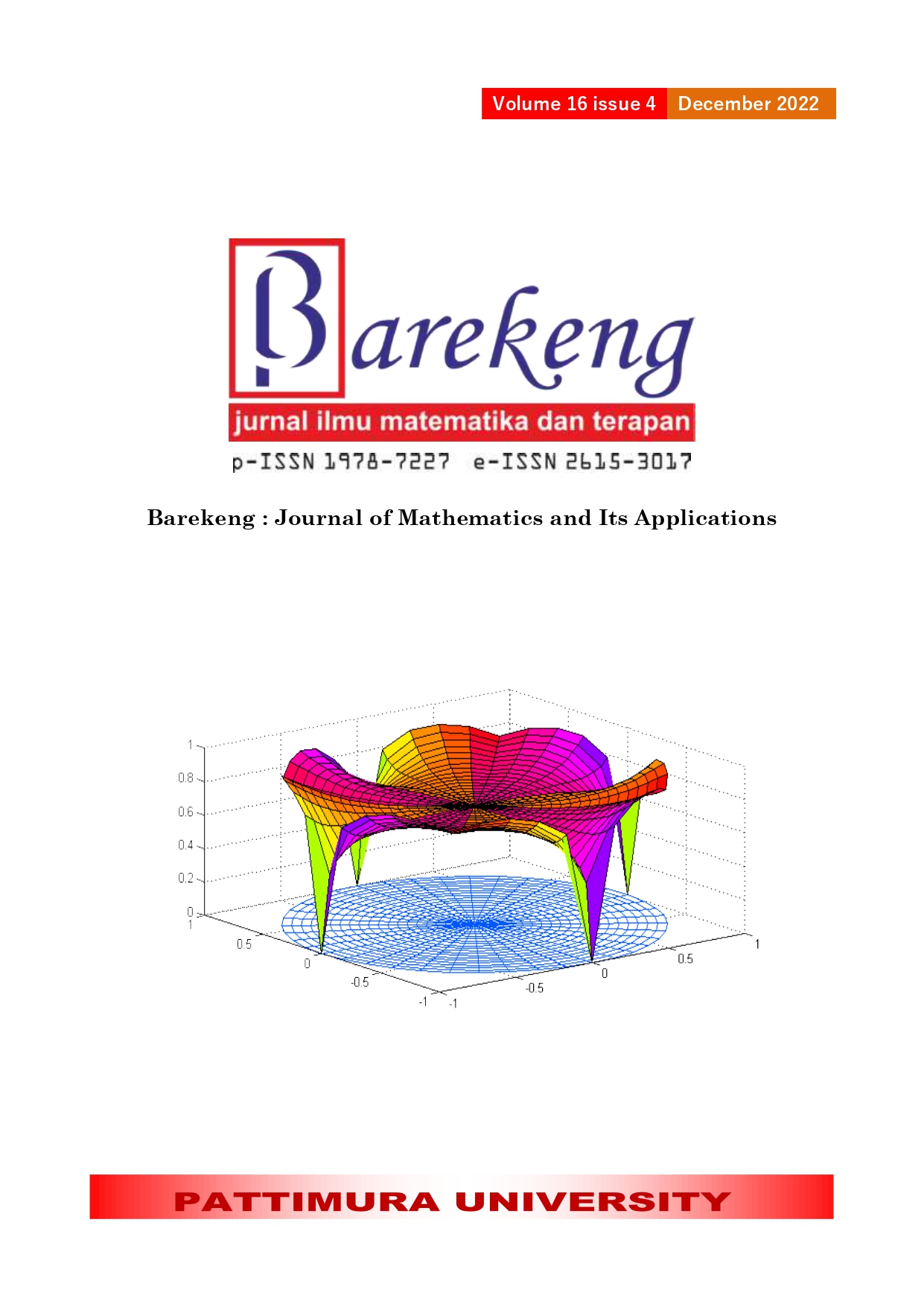BICLUSTERING APPLICATION IN INDONESIAN ECONOMIC AND PANDEMIC VULNERABILITY
Abstract
Biclustering is an analytical tool to group data from two dimensions simultaneously. The analysis was first introduced by Hartigan (1972) and applied by Cheng and Church (2000) to the gene expression matrix. The Cheng and Church (CC) algorithm is a popular biclustering algorithm and has been widely applied outside the field of biological data in recent years. This algorithm application in economic and Covid-19 pandemic vulnerability cases is exciting and essential to do in order to get an overview of the spatial pattern and characteristics of the bicluster of economic and COVID-19 pandemic vulnerability in Indonesia. This study uses secondary data from some ministries. Forming a bicluster using the CC algorithm requires determining the delta threshold so that several types of delta thresholds are formed to choose the best (optimum) using the evaluation of the average value of mean square residue (MSR) to volume ratios. The similarity of the optimum bi-cluster with the other is also seen based on the Liu and Wang index values. The 0.01 delta threshold is chosen as the optimum threshold because it produces the smallest average value of MSR to volume ratios (0.00032). Based on Liu and Wang Index values, the optimum threshold has a similarity level below 50% with other types of delta thresholds, so the threshold is the best unique threshold. The optimum threshold resulted in six biclusters (six spatial patterns). Most regions in Indonesia (11 provinces) tend to have low economic and COVID-19 pandemic vulnerability in the first spatial pattern characteristic variables.
Downloads
References
J. A. Hartigan, “Direct clustering of a data matrix,” J. Am. Stat. Assoc., vol. 67, no. 337, pp. 123–129, 1972, doi: 10.1080/01621459.1972.10481214.
Y. Cheng and G. M. Church, “Biclustering of expression data.,” Proc. Int. Conf. Intell. Syst. Mol. Biol., vol. 8, pp. 93–103, 2000.
United Nations, “EVI Indicators,” 2011. ipb.link/un-evi (accessed Apr. 27, 2021).
National Institute of Environmental Health Sciences, “Details for PVI Maps,” 2020. ipb.link/niehs (accessed Apr. 27, 2021).
B. Yuniarto and R. Kurniawan, “Understanding Structure of Poverty Dimensions in East Java: Bicluster Approach,” Signifikan J. Ilmu Ekon., vol. 6, no. 2, pp. 289–300, 2017, doi: 10.15408/sjie.v6i2.4769.
C. A. Putri, R. Irfani, and B. Sartono, “Recognizing poverty pattern in Central Java using Biclustering Analysis,” J. Phys. Conf. Ser., vol. 1863, no. 1, 2021, doi: 10.1088/1742-6596/1863/1/012068.
R. Novidianto and R. Irfani, “Bicluster CC Algoritm Analysis to Identify Patterns of Food Insecurity in Indonesia,” J. Mat. Stat. dan Komputasi, vol. 17, no. 2, pp. 325–338, 2020, doi: 10.20956/jmsk.v17i2.12057.
B. Pontes, R. Giráldez, and J. S. Aguilar-Ruiz, “Biclustering on expression data: A review,” J. Biomed. Inform., vol. 57, pp. 163–180, 2015, doi: 10.1016/j.jbi.2015.06.028.
Nurmawiya and R. Kurniawan, “Pengelompokan Wilayah Indonesia Dalam Menghadapi Revolusi Industri 4.0 Dengan Metode Biclustering,” pp. 790–797, 2020.
P. A. Kaban, R. Kurniawan, R. E. Caraka, B. Pardamean, B. Yuniarto, and Sukim, “Biclustering method to capture the spatial pattern and to identify the causes of social vulnerability in Indonesia: A new recommendation for disaster mitigation policy,” Procedia Comput. Sci., vol. 157, pp. 31–37, 2019, doi: 10.1016/j.procs.2019.08.138.
H. Cho and I. S. Dhillon, “Coclustering of human cancer microarrays using minimum sum-squared residue coclustering,” IEEE/ACM Trans. Comput. Biol. Bioinforma., vol. 5, no. 3, pp. 385–400, 2008, doi: 10.1109/TCBB.2007.70268.
H. Ben Saber and M. Elloumi, “A Comparative Study of Clustering and Biclustering of Microarray Data[,” Int. J. Comput. Sci. Inf. Technol., vol. 6, no. 6, pp. 93–111, 2014, doi: 10.5121/ijcsit.2014.6607.
N. Kavitha Sri and R. Porkodi, “An extensive survey on biclustering approaches and algorithms for gene expression data,” Int. J. Sci. Technol. Res., vol. 8, no. 9, pp. 2228–2236, 2019.
A. Chakraborty and H. Maka, “Biclustering of gene expression data using genetic algorithm,” Proc. 2005 IEEE Symp. Comput. Intell. Bioinforma. Comput. Biol. CIBCB ’05, vol. 2005, no. 2000, 2005, doi: 10.1109/cibcb.2005.1594893.
X. Liu and L. Wang, “Computing the maximum similarity bi-clusters of gene expression data,” Bioinformatics, vol. 23, no. 1, pp. 50–56, 2007, doi: 10.1093/bioinformatics/btl560.
Copyright (c) 2022 Wiwik Andriyani Lestari Ningsih, I Made Sumertajaya, Asep Saefuddin

This work is licensed under a Creative Commons Attribution-ShareAlike 4.0 International License.
Authors who publish with this Journal agree to the following terms:
- Author retain copyright and grant the journal right of first publication with the work simultaneously licensed under a creative commons attribution license that allow others to share the work within an acknowledgement of the work’s authorship and initial publication of this journal.
- Authors are able to enter into separate, additional contractual arrangement for the non-exclusive distribution of the journal’s published version of the work (e.g. acknowledgement of its initial publication in this journal).
- Authors are permitted and encouraged to post their work online (e.g. in institutional repositories or on their websites) prior to and during the submission process, as it can lead to productive exchanges, as well as earlier and greater citation of published works.






1.gif)



